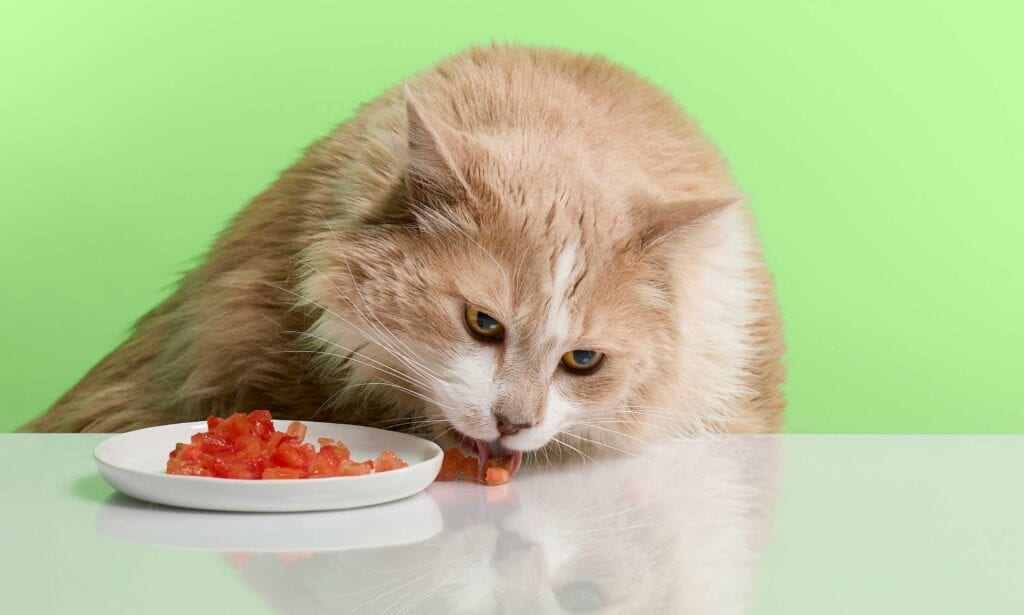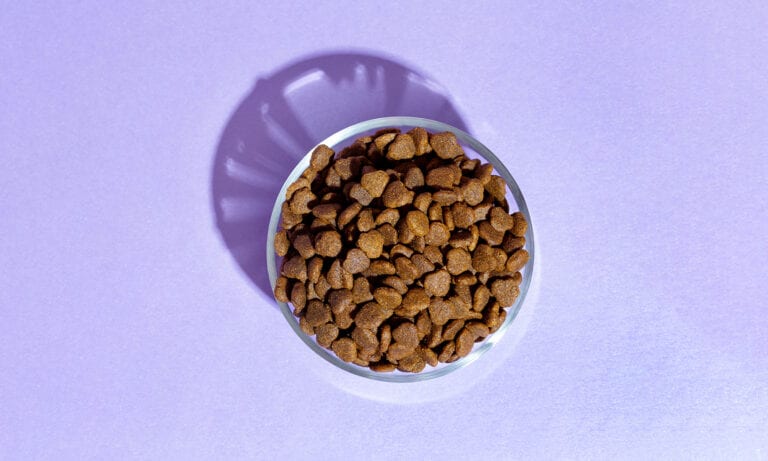Plump, juicy and versatile, tomatoes are the unsung heroes of salads, sandwiches and sauces. In moderation, even dogs can enjoy ripe, red tomatoes. But can cats eat tomatoes, too?
Here’s the short answer: Occasionally giving your cat a small piece of fresh, red, ripe tomato is generally considered safe. However, green tomatoes (which are unripe fruit), stems and leaves, and tomato products, like canned tomatoes and tomato sauces, should be avoided.
For a more complete understanding of this purr-plexing topic, keep reading! We spoke to a vet expert to get the specifics and understand the potential benefits and risks of giving this juicy, red, ripe fruit to your kitty.
Click to jump to each section:
Can Cats Eat Tomatoes?
While the flesh of red, ripe tomatoes isn’t toxic to cats in the way some foods such as chocolate or grapes are, they’re not recommended as a regular part of a feline diet. Why? Because as obligate carnivores, a cat’s digestive system is optimized for meat consumption—not plant-based foods like veggies and fruits.
That said, sharing a nibble of tomato with your fur baby is generally safe, as long as it’s the right kind. So, which types and preparations of tomatoes are safe for a cat’s health and which should be avoided?
Here are the guidelines to follow:
- Plain and fresh: Stick to plain, red, fresh tomatoes. Commercial tomato products like canned tomatoes, tomato sauce, tomato juice, ketchup and canned tomato soup often contain a medley of spices and seasonings that are harmful to cats. Garlic and onion are particularly toxic to felines, as they can cause anemia.
- Red and ripe: Only offer your cat the ripe, red flesh of the tomato. Any portion of the green unripe fruit, as well as the leaf or stem, is not safe for cats to eat, as these parts contain toxic chemicals called solanine and tomatine.
- Go organic: If possible, opt for organic tomatoes, which are free from pesticides and herbicides. Regardless of whether the tomato is organic or non-organic, always wash it well to remove any residue or dirt.
- Small amounts: Tomatoes should be an occasional treat, not a dietary staple. A small bit or two is enough for your cat to experience the taste without upsetting their digestive system. Large quantities can cause diarrhea or tummy trouble for cats.
Another way to safely give your cat tomatoes is by opting for commercial cat food that contains tomatoes. In such products, the type and quantity of tomatoes are carefully measured and formulated to be safe for cats, taking the guesswork out of the equation for you.
Here are a few good cat foods containing tomatoes to try:
Temporarily out of stock
Benefits of Tomatoes for Cats
Tomatoes are a low-calorie nutritional powerhouse for humans, rich in antioxidants like lycopene, essential vitamins like vitamin C and K, and minerals like potassium.
However, a cat’s digestive system isn’t designed to extract nutrients from plant-based foods efficiently, so many of the vitamins and minerals found in tomatoes don’t offer the same nutritional advantages to cats as they do to humans.
That being said, there are still some notable health benefits to consider, including:
- Hydration: Composed of 94 percent water, tomatoes could offer your kitty some extra hydration. But plain water and wet cat food are always the best options for hydration.
- Fiber: The fiber in tomatoes could support digestion, although cats generally get all the fiber they need from their regular high-quality cat food.
- Enrichment: Cats can be curious creatures, and introducing a new, safe food item could provide some mental stimulation.
Risks of Tomatoes for Cats
It’s crucial to be aware of the potential risks and adverse effects of offering tomatoes to your feline friend.
Here are the primary concerns:
Toxic Components
Tomatoes contain a poisonous chemical called solanine (common to all members of the Solanaceae family of plants, commonly known as the nightshade family). While it’s present in red, ripe tomatoes in small, safe amounts, it can be found in higher concentrations in the green, unripe parts of the fruit and other parts of the tomato plant, including the leaves and stems.
Tomatine is another toxic chemical—concentrated in the unripe flesh, stems and leaves of tomato plants—that can be harmful to cats. Cats who consume too much of these chemicals via tomatoes can experience tomato poisoning.
Symptoms include:
- Nausea
- Vomiting
- Diarrhea
- Loss of appetite
- Slow heart rate
- Dilated pupils
- Drooling
- Tremors
Tomato poisoning, if a lot of the plant is eaten, has the potential to be life-threatening if not promptly and appropriately treated by a veterinarian.
Digestive Issues
Cats’ digestive systems are specifically tailored for processing meat—not plant matter. While a small amount of ripe tomato generally won’t cause any gastrointestinal upset for your cat, their digestive system is not well-equipped to handle large amounts of tomato (or other plant-based foods).
If your cat consumes a larger quantity of tomatoes, they may experience stomach upset with symptoms like vomiting, diarrhea or apparent discomfort.
Harmful Added Ingredients
Commercially prepared tomato products, like canned tomatoes or tomato sauce, often include additional spices, salt, sugar or preservatives that aren’t suitable for cats. Garlic and onion are particularly dangerous and should always be avoided.
FAQs About Tomatoes and Cats
Q:
What happens if my cat eats a tomato?
A:If your cat eats a small amount of ripe, red tomato, there’s no need to worry. However, you should contact your veterinarian in the following instances:
- If your cat consumes a large amount of ripe tomato
- If your cat consumes green, unripe tomato or the stems or leaves of a tomato plant
- If your cat experiences any sort of symptoms after consuming tomato
You can also call the ASPCA Animal Poison Control Center at (888) 426-4435 for advice.
Q:
Why does some cat food have tomatoes in it?
Q:
Can cats eat cooked tomatoes?
More foods cats can eat:
Share:















